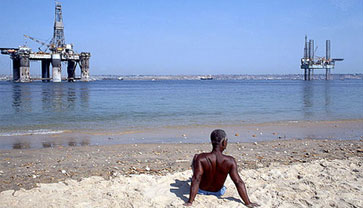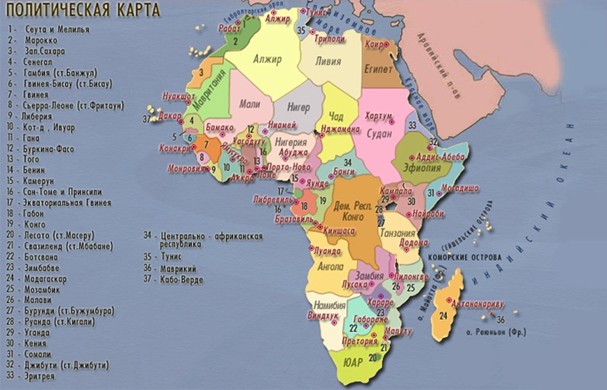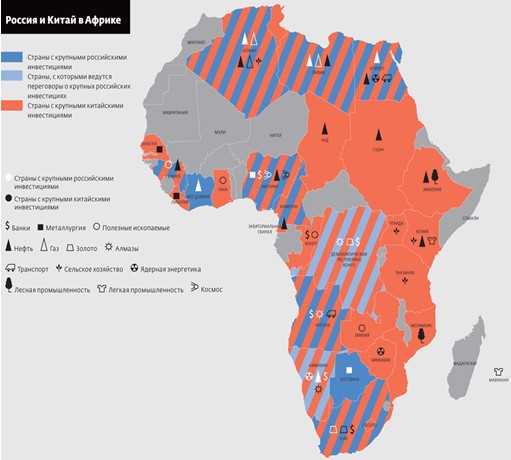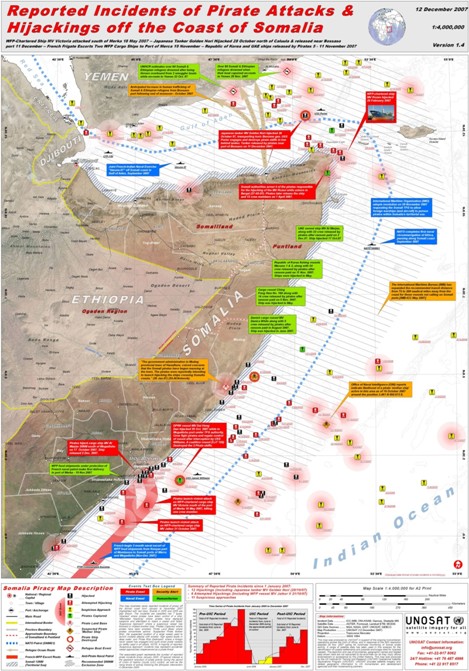 18.05.2011
18.05.2011REFLECTING THE EVENTS OF THE AFRICAN CONTINENT IN THE MIRROR OF THE GREAT GAME
G.Harutyunyan - Executive Director, Noravank Foundation
The beginning of 2010 was marked by an onset of a series of powerful transformational processes on the African continent. The majority of the “civilized world” re-discovered Africa after the 2010 FIFA World Cup in Johannesburg, which attracted not only tourists, but also the attention of the world mass media to South Africa and its problems.
However, the recent events in Egypt drew a very special interest as they led to change of the political course in this key African country. These events are determinative in many respects for the destiny of the whole continent; it is not for nothing that Egypt was called “gateway to Africa” since prehistoric times.
Let us attempt sorting through what stood behind such turbulent events that swept through the “black continent” like a tsunami.
Africa on the Geopolitical and Geo-economic Maps of the Modern World
By the beginning of the 19th century only two continents on the planet remained unaffected by globalization processes; these were Africa and Antarctica. Remoteness and harsh climate of the latter held back its industrial development, whereas re-colonization of the former essentially was only a matter of time.
The “black” continent covers an area of 30.3 million km2. The distance between the northernmost and southernmost points is 8,000 km, and between the westernmost and easternmost points in northern part of the continent it is 7,500 km. 1
Africa is known for its mineral resources, especially the rich deposits of diamond (RSA, Zimbabwe) and gold (RSA, Ghana, Mali, Republic of Congo). There are large oil fields in Nigeria and Algeria. Bauxites are mined in Guinea and Ghana. Phosphorite resources, as well as manganese, iron and lead-zinc ores are concentrated in the northern coastal zone of Africa (see Fig. 1).

Figure 1. Mineral resources of Africa (source: http://baigigitov.narod.ru/kartu.htm).
Historically, due to climate traits the continent remained outside the limits of the industrial society’s expansion. However, it did not skip the attention of the western countries. The African continent fell in the meat grinder of colonization since the 16th century.
After the World War II, decolonization process in Africa gained momentum. 1960 was declared the Year of Africa (the year of freedom for the largest number of colonies), when thirteen states gained independence (today the number has reached 37 – see Fig. 2). Most of these were former French colonies or French governed UN mandate territories: Cameroun, Togo, Malagasy Republic, Congo (formerly French Congo), Dahomey, Upper Volta, Ivory Coast, Chad, the Central African Republic, Gabon, Mauritania, Niger, Senegal and Mali. The most populous African country, Nigeria gained its independence from the United Kingdom, and the largest country by area, Belgian Congo also achieved independence. British Somaliland and UN trusteeship territory of Italian Somaliland were united and became Somali Democratic Republic.

Figure 2. Political Map of Africa (source: http://baigigitov.narod.ru/kartu.htm).
Upon gaining independence many of the African countries plunged into civil wars, which was caused by the realities that, on one hand, during the “Scramble for Africa” the borders of African countries were drawn in an artificial manner, without any regard to the actual settlement areas of various ethnicities and tribes, and on the other hand, the traditional African society was not ready for democratic governance reforms. In many countries power was seized by dictators. As a result, such regimes are notorious for their neglect of human rights, bureaucracy, totalitarianism, which lead to, above all, economic crises and growing poverty.
State borders in Africa are just one example out of many as far as the postcolonial policies of Great Britain and its allies are concerned. These policies boil down to the following: having realized that political transformation processes along with their dynamic would not allow a full control over the colonial territories, the UK leadership would make a decision to “declare sovereignty.”
Being well aware of the actual state of affairs and clearly realizing the conflict-generating potential of their former colonies, the United Kingdom actively participated in building the statehoods of the independent nations, as a “sophisticate” political adviser. It is in this very matter that the craftiness of the UK colonial policy manifests itself; the state borders were drawn in a manner that a hidden potential of conflicts has been preserved or formed anew for many decades (if not longer) ahead, and any time a minor external thrust may bring these conflicts from their dormant state to a heated confrontation in an internecine war. Such policies have been implemented in relation to Israel and Palestine, India and Pakistan, to some extent also in Central Asia, and especially this is the case for Africa.
Hence, most of the modern conflicts on the African continent had been programmed beforehand by the “enlightened West”, so that there would always be an excuse to return back to their colonies under the banner of “the mission to pacify” the feuding parties.
And the time for this came at the beginning of the 21st century, characterized by deep financial and economic shocks of the Western civilization, which resulted in years-long financial and economic crisis, as well as inter-confessional clashes.
Competitive Struggle of the Transnational Corporations for Africa
Before the beginning of the 21st century transnational corporations (TNC) were especially interested in Africa as a source of raw materials supplied for giveaway prices. On one hand, such interest led to exacerbation of internal conflicts caused by unscrupulous competition, on the other hand, it allowed maintaining a relative “tranquility” as each TNC would calm down after having gained access to the needed resource. The struggle between TNCs in Africa is best illustrated by the situations in Congo and neighboring Rwanda.
Rapid development of the Western industrial economy requires access to new resources. The case of one such resource, coltan, is well described in the article The Blood in Cell Phone2, the author of which correctly points out the following remarkable facts about one of the African countries, Congo. Congo is regarded as one of the richest countries in the world for its resources, while its population is at the bottom of the poverty list.
We all use cell phones. Up to half billion phones are sold annually and each of them contains columbite-tantalite extracted from coltan ore. 80% of the world coltan reserves are in Congo. In addition to that one-third of diamond deposits, half of cobalt and one-quarter of uranium reserves, as well as considerable oil reserves, copper, gold and silver deposits are in the same country. As one of the richest nations of the world Congo could have afforded a standard of living at least equal to that of Emirates. However, there is a company called America Mineral Fields Inc., and also Nokia, Siemens, not to mention Cabot (USA) H.C. Starck (Germany), Ningxia (China) and scores of others that would not let that happen…
The fighting dubbed Congo Civil War or Second African War or World Coltan War hardly ever stopped in the country over the last 50 years.
The coltan supply scheme per se is very complicated3. Individual diggers in Congo manually mine it and pass it to small resellers. These, in turn, rent privately owned Ukrainian and Russian airplanes to transport the unprocessed ore to the neighboring countries (mostly Rwanda). Then the cargo exported from Congo is shipped to Europe through government companies that belong to the relatives of Rwandan and Ugandan presidents. Here Belgian companies play the primary role. Most of the shipments arrive in Ostend airport (a transit center); the planes transport back weapons, while the coltan cargo is dispatched to processing plants through companies registered somewhere, say, in Cyprus. The number of these plants is small, and their owners are in essence the main sponsors of the war in Congo: Cabot (USA), H.C. Starck (Germany), Ningxia (China) and a processing plant in Ust-Kamenogorsk, Kazakhstan.
The Chinese Development Vector for Africa
The global geopolitical situation began to change drastically at the end of the 20th century, when a new supernova, China, emerged on the horizon. Analysts of the world’s leading think-tanks forecasted that the forthcoming years will pass under the sign of China’s development. In the second half of the 20th century the forward-looking policy of the Soviet leadership supported by Cuba, GDR and Yugoslavia brought the USSR to the forefront in Africa. However, the collapse of the USSR left a geopolitical vacuum, which undoubtedly, could not remain for too long, and other actors came forward, among which China was the one to take over the USSR’s place.

Figure 3. Russia and China in Africa (source: http://www.krasrab.com/archive/2010/11/09/07/view_article).
The situation change became even more dynamic in the first decade of the 21st century. For instance, in 2008 American intelligence forecasts, as well as those of other analytical centers of the Western countries stated with alarm that by 2025 China may become the second most powerful nation in the world in terms of economy and military strength, and after 20 more years it may even take the first position4.
A developing economy needs resources. Essentially, China faces a serious and crucial choice in determining the key vector of its own development. However, there are not too many vectors to choose from.
One of them is South-East Asia and Oceania. It is quite a promising direction, but it may lead China to a conflict not only with Japan and USA, but also with the United Kingdom, which has its own interests in the countries of the British Commonwealth. For China it is still impossible to handle a competition like that.
Another vector is Siberia and the Russian Far East. It is a very attractive direction that gives the Chinese economy an opportunity of access to the Russian oil and gas reserves. Nevertheless, substantial problems exist here (in addition to the harsh climate) which cannot be fully resolved by China, although it successfully implements a program of soft expansion into the Russian lands.
The third vector is Africa.
In an article most comprehensively analyzing the evolution of the African vector in China’s foreign policy, the renowned Russian author Roy Medvedev5 remarks that political cooperation between China and many of the African countries has already been developing in 1960-1970s, within the framework of alliance for anti-imperialistic struggle.
Since mid-1990s the main focus shifted to economic cooperation between China and Africa. As early as 1996 the Vice Premiers of China three times toured Africa visiting total 18 countries. In 1996 PRC President Jiang Zemin visited Kenya, Ethiopia, Mali, Egypt, Namibia and Zimbabwe. In May 1997 PRC State Council Premier Li Peng visited six countries of the African tropical zone. In these years PRC trade turnover with African countries was about $4 billion annually. That was an insignificant number even then, as it comprised just about 1.5% of China’s total foreign trade turnover6.
R. Medvedev notes in his article that in the late 1990s a plan of cooperation with African countries was developed in China, which was extensively implemented afterwards in 2000-2009. Just the fact that by early 2008 the trade turnover with African countries reached $108 billion is a proof for that. China’s direct investments in the Black Continent reached $8 billion in 2008 alone. In 2009 China became the second largest trade partner of Africa, after Europe. Volumes of trade between China and Africa have been growing 30% annually over the last five years. In 2000-2003 China partially or fully wrote off the debts of some African countries amounting to over $1.5 billion7.
Unlike the Western countries, China does not put forward such requirements of developing democracy that are still premature or impossible to meet. For instance, China actively cooperates with the regime in Sudan, overlooking the fact that in 2008 the International Criminal Court has issued an arrest warrant for the Sudanese president Omar Bashir. China badly needs the oil resources of Sudan estimated at approximately 2 billion barrels. This is where almost all of the oil exported from Sudan end ups. However, China lends money to Sudan for building not only oil pipelines, but also schools, hospitals and roads8.
In these circumstances the January, 2010 referendum for independence of South Sudan9 was a serious blow to the Chinese interests, because the key oil fields are concentrated exactly in the south of the country. Quite characteristically, the conflict between North and South Sudan was programmed since the times of British protectorate over this country10.
As it is noted in R. Medvedev’s article, since spring 2007 China launched a major project for establishing “special economic zones” in Africa. In this case the successful experience of 1980-1990s in creating such zones in China itself is used. The first “special zone” is being set up in the “Copperbelt” in Zambia. The second one is on Mauritius Island and it will serve as a trade center for China to provide a privileged access to trading structures of 21 member-states of the Common Market for Eastern and Southern Africa for over 40 directions of Chinese businesses. Mauritius will afford China a freer access to the Indian Ocean and markets of Eastern and Southern Africa. A third “zone” is supposed to be created in Tanzanian capital Dar es Salaam to turn it into a shipping hub. Two more “special zones” were planned for Western Africa, and Liberia, Nigeria and Cape Verde have been competing to host those11.
It was also mentioned that in November, 2009 a diligently prepared summit took place in Beijing attended by 48 leaders from African countries. In his address to the summit the Chinese president Hu Jintao criticized the policies of the Western countries in Africa and promised a twofold increase of aid to the African continent in 2009. This promise has been fulfilled. A multi-billion dollar investment fund has been established for Africa and besides, large investments and credits will be directed to specific countries. For example, after having received a $2 billion loan from China, Angola lost interest in IMF credits, which are tied with numerous conditionalities12.
Thus the African vector in China’s foreign policy development was practically implemented in a scrupulous manner.
The Struggle for World Supremacy is Currently Decided Africa
Understandably, the main geopolitical competitor of China – the USA – could not have put up with the fact that the Chinese economy received a powerful boost through enormous resources of the African continent.
For the analysts’ forecasts on growth of the Chinese economy to materialize, that economy needs to be fed by inexpensive raw materials. At the beginning of the 21st century it became crystal clear that Africa is the source for such raw materials for China.
Intensifying struggle for Africa initially manifested itself in the early 21st century by the phenomenon of “piracy” off the Somalia coast13, 14. Increase of pirate activity in 2006-2007 coincided with the launch of China’s program of economic expansion to Africa.

Figure 4. Somalia Piracy Map (source: http://www.unitar.org/unosat/).
Peculiarities of these pirate raids allow one to assume that their activities are controlled and directed by some “firm hand.” The widely publicized capture of the Ukrainian vessel MV Faina with heavy weapons on board was carried out based on information passed to the Somali pirates from Odessa15. It is also interesting that the USA and UK are major opponents of international legislation on fighting piracy and have blocked relevant initiatives put forward by other countries at the UN level16.
The severity of the USA-China confrontation especially heightened by dispute of these powers over the world financial and currency system reforms, which surfaced after the 2010 G20 Seoul Summit. The dispute of two superpowers crystallized into a “hot” conflict between their dominions on the Korean Peninsula. Against this backdrop it is obvious that the ensuing events in a number of African countries in early 2011 are a reflection of the struggle between the USA and China for the leadership role in the world.
As mentioned above, the developments in Sudan contributed to strengthening of the US positions in the country and diminishing the influence of China in oil-rich regions there.
In very much the same manner, turmoil in Egypt was also caused by the standoff between the USA and China, though in this case it was also intersected by effects of the regional tension, first of all between Israel and Iran.
Escalating developments around Iran required Israel to take measures for upholding the situation in the neighboring countries. In this context the Mubarak regime in Egypt no longer suited the interests of Israel, and any further complication of the situation around Iran might have led to hazards posed on Israel from this direction.
Conclusions
The example of Egypt events is an evidence of the Great Game actions on the global chessboard.The fact that the Russian president’s visit to Israel in January, 2010 was canceled is also one of the components of the same game and the Israeli diplomats’ strike had very little to do with that. Simply, on the eve of critical events for the region presence of the leader of Russia, successor of the great USSR, in an official state visit to one of the key countries of the region was considered inexpedient by the “masterminds.”
The severity and dynamism of developments yet again prove the tension in the global state of affairs, as well as that there is no clear-cut plan to overcome this grave situation.
Once again we were convinced that the world is on the verge of fundamental geopolitical transformations: there is no doubt that the occurring events will not skip China’s attention and it will prepare a response in a very near future. Whether it is going to be overthrows of ruling regimes in the regional US satellites (first of all, Saudi Arabia) or a more sophisticated response staged elsewhere on the planet, it is something we shall know soon.
1http://en.wikipedia.org/wiki/Geography_of_Africa.
2 http://commons.com.ua/archives/8523.
3 http://commons.com.ua/archives/8523.
4 http://www.csef.ru/studies/politics/projects/china/articles/875/.
5 http://www.krasrab.com/archive/2010/11/09/07/view_article.
6 http://www.krasrab.com/archive/2010/11/09/07/view_article.
7 http://www.krasrab.com/archive/2010/11/09/07/view_article.
8 http://www.krasrab.com/archive/2010/11/09/07/view_article.
9 http://www.noravank.am/rus/articles/detail.php?ELEMENT_ID=5322.
10 http://www.noravank.am/rus/articles/detail.php?ELEMENT_ID=5322.
11 http://www.krasrab.com/archive/2010/11/09/07/view_article.
12 http://www.krasrab.com/archive/2010/11/09/07/view_article.
13 http://www.iimes.ru/rus/stat/2010/26-05-10.htm.
14 http://badnews.org.ru/news/kto_rukovodit_somalijskimi_piratami/2010-05-19-1210.
15 http://www.newsru.com/world/13feb2009/pirates.html.
16 http://blog.i.ua/user/3169528/512534/.
Return
Another materials of author
- HYBRID CHALLENGES TO INTEGRATION PROCESSES 2[13.02.2020]
- HYBRID CHALLENGES TO INTEGRATION PROCESSES 1[13.02.2020]
- CRITICAL INFRASTRUCTURES AND IDEOLOGY[25.01.2018]
- SCIENTIFIC AND TECHNOLOGICAL LANDSCAPE OF THE MULTIPOLAR WORLD[23.01.2018]
- “COLOR REVOLUTIONS”[16.01.2017]
- INFORMATION WARFARE OF THE NEW FORMATION[26.12.2016]
- THE GROWTH OF EXTREMISM AND THE FACTOR OF “INTELLECTUAL PARITY”[22.09.2015]
- THE GROWTH OF EXTREMISM AND THE FACTOR OF “INTELLECTUAL PARITY”[31.08.2015]
- ARMENIAN STUDIES IN THE SYSTEM OF NATIONAL SECURITY[07.05.2015]
- EEU AND ARMENIA[15.12.2014]
- HUMAN RIGHTS ABUSES IN AZERBAIJAN TOO BLATANT TO COVER UP[06.10.2014]
